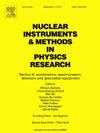Optical characterization of UV-transmitting acrylics for the Hyper-Kamiokande multi-PMT module
IF 1.5
3区 物理与天体物理
Q3 INSTRUMENTS & INSTRUMENTATION
Nuclear Instruments & Methods in Physics Research Section A-accelerators Spectrometers Detectors and Associated Equipment
Pub Date : 2025-04-16
DOI:10.1016/j.nima.2025.170488
引用次数: 0
Abstract
The Hyper-K project aims to construct a large-volume underground water Cherenkov detector to address unresolved questions in fundamental particle physics. The Hyper-Kamiokande far detector (HK) will incorporate various types of photodetectors, among which the multi-photomultiplier tube (mPMT) optical module providing critical directional information. To house the electronics and photodetectors, the mPMT vessel must meet specific criteria: (i) transparency in the visible and ultraviolet ranges, covering the spectrum of Cherenkov photons; (ii) an airtight seal to maintain optimal functionality in a dry, controlled environment; and (iii) resilience to the hydrostatic pressure of the HK water tank, which reaches 0.8 MPa. While glass has traditionally been used to fulfill these requirements, its intrinsic radioactivity may compromise the sensitivity of Hyper-K measurements. Acrylic that is transparent, impermeable and robust, by contrast, offers the advantage of a low-radioactivity. Optical characterizations were performed on various acrylic samples, revealing that optical performance is influenced not only by the material composition but also by the production processes used to achieve different thicknesses. Our findings support the use of acrylic as a viable alternative, but it is essential to rigorously monitor the material’s performance during mass production to ensure optimal and uniform detector performance.
Hyper-Kamiokande多pmt模块中uv透射丙烯酸树脂的光学特性
Hyper-K项目旨在建造一个大容量的地下水切伦科夫探测器,以解决基本粒子物理学中尚未解决的问题。超神冈远探测器(HK)将包括各种类型的光电探测器,其中多光电倍增管(mPMT)光模块提供关键的方向信息。为了容纳电子设备和光电探测器,mPMT船必须满足特定的标准:(i)可见光和紫外线范围的透明度,覆盖切伦科夫光子的光谱;(ii)在干燥、受控的环境中保持最佳功能的密封;(iii)对HK水箱静水压力的弹性,达到0.8 MPa。虽然传统上使用玻璃来满足这些要求,但其固有的放射性可能会损害Hyper-K测量的灵敏度。丙烯酸是透明的,不透水的和坚固的,相比之下,提供了低放射性的优势。对各种丙烯酸样品进行了光学表征,揭示了光学性能不仅受到材料成分的影响,还受到用于实现不同厚度的生产工艺的影响。我们的研究结果支持使用丙烯酸作为可行的替代品,但在大规模生产期间严格监控材料的性能以确保最佳和均匀的检测器性能至关重要。
本文章由计算机程序翻译,如有差异,请以英文原文为准。
求助全文
约1分钟内获得全文
求助全文
来源期刊
CiteScore
3.20
自引率
21.40%
发文量
787
审稿时长
1 months
期刊介绍:
Section A of Nuclear Instruments and Methods in Physics Research publishes papers on design, manufacturing and performance of scientific instruments with an emphasis on large scale facilities. This includes the development of particle accelerators, ion sources, beam transport systems and target arrangements as well as the use of secondary phenomena such as synchrotron radiation and free electron lasers. It also includes all types of instrumentation for the detection and spectrometry of radiations from high energy processes and nuclear decays, as well as instrumentation for experiments at nuclear reactors. Specialized electronics for nuclear and other types of spectrometry as well as computerization of measurements and control systems in this area also find their place in the A section.
Theoretical as well as experimental papers are accepted.

 求助内容:
求助内容: 应助结果提醒方式:
应助结果提醒方式:


